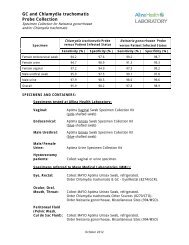Human (Granulocytic) Anaplasmosis (HGA ... - Allina Health
Human (Granulocytic) Anaplasmosis (HGA ... - Allina Health
Human (Granulocytic) Anaplasmosis (HGA ... - Allina Health
You also want an ePaper? Increase the reach of your titles
YUMPU automatically turns print PDFs into web optimized ePapers that Google loves.
BABESIOSIS<br />
Babesiosis (originally called “Nantucket fever” due to its initially recognized occurrence in the<br />
late 1960s on Nantucket Island) is a malaria-like illness caused by an apicomplexan protozoan.<br />
These organisms are found worldwide. Although there are many species, only a few are identified<br />
as causing human disease, including: B. microti, B. divergens, B. duncani (WA1 species),<br />
and a strain designated MO-1. Like malaria, Babesia species infect erythrocytes, but unlike<br />
malaria, babesiosis is transmitted by ticks, and the organism is found in a variety of animal<br />
species that serve as reservoirs. Our previously mentioned “friend” Ixodes scapularis (deer<br />
tick, blacklegged tick) is the usual tick vector.<br />
<strong>Human</strong> infections in the United States of America occur mainly in the upper Midwest and<br />
northeastern states due to infection by the rodent parasite Babesia microti (which infects the<br />
white-footed mouse and other small mammals and which is the main species that infects people<br />
in the United States). Tick larvae hatch in early summer from eggs laid in the spring by<br />
adult female ticks, and become infected when they take a blood meal from infected whitefooted<br />
mice. They molt into infected nymphs the following spring, and when they feed on<br />
mice or humans in late spring or early summer, these hosts then also become infected. The<br />
parasite is usually spread to humans by the young nymph stage of the tick (at which time the<br />
tick is about the size of a poppy seed). In the fall, the nymphs molt into adults that feed on<br />
white-tailed deer (that, according to some sources, do not become infected but nevertheless<br />
support/amplify the tick population by providing the blood meals); if these infected adult ticks<br />
feed instead on humans, they can infect humans at this time, as well. Thus, the main mode of<br />
transmission to humans is through the bite of an infected tick (usually nymph, sometimes<br />
adult), when humans engage in outdoor activities where Babesiosis is found.<br />
In human infection, the sporozoites which are introduced into the bloodstream by the biting<br />
tick attach to and enter the red blood cells (erythrocytes), where they mature into trophozoites<br />
that eventually bud to form four merozoites (these stages are visible via light microscopy,<br />
the four-merozoite stage sometimes characterized by the so-called “Maltese cross” formation<br />
in infected red blood cells).<br />
Babesia microti infection, Giemsa-stained thin smear<br />
5
















